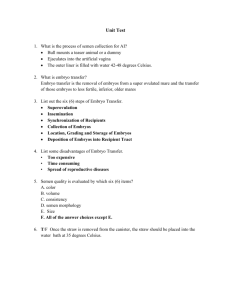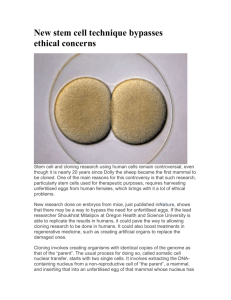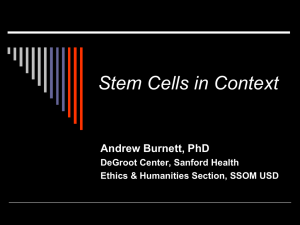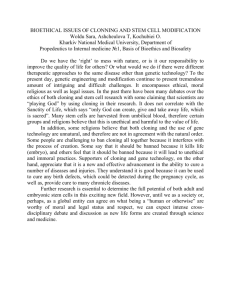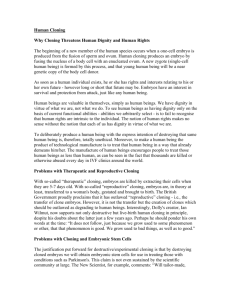from what stage a cell or cellular artifact may be qualified as an
advertisement
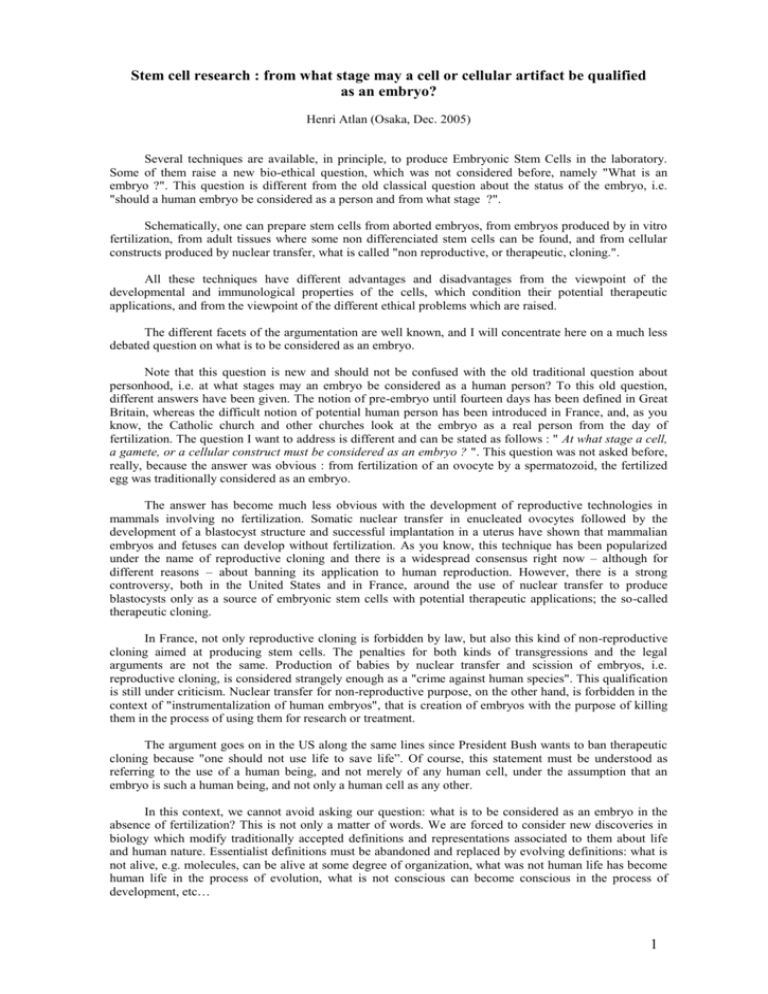
Stem cell research : from what stage may a cell or cellular artifact be qualified as an embryo? Henri Atlan (Osaka, Dec. 2005) Several techniques are available, in principle, to produce Embryonic Stem Cells in the laboratory. Some of them raise a new bio-ethical question, which was not considered before, namely "What is an embryo ?". This question is different from the old classical question about the status of the embryo, i.e. "should a human embryo be considered as a person and from what stage ?". Schematically, one can prepare stem cells from aborted embryos, from embryos produced by in vitro fertilization, from adult tissues where some non differenciated stem cells can be found, and from cellular constructs produced by nuclear transfer, what is called "non reproductive, or therapeutic, cloning.". All these techniques have different advantages and disadvantages from the viewpoint of the developmental and immunological properties of the cells, which condition their potential therapeutic applications, and from the viewpoint of the different ethical problems which are raised. The different facets of the argumentation are well known, and I will concentrate here on a much less debated question on what is to be considered as an embryo. Note that this question is new and should not be confused with the old traditional question about personhood, i.e. at what stages may an embryo be considered as a human person? To this old question, different answers have been given. The notion of pre-embryo until fourteen days has been defined in Great Britain, whereas the difficult notion of potential human person has been introduced in France, and, as you know, the Catholic church and other churches look at the embryo as a real person from the day of fertilization. The question I want to address is different and can be stated as follows : " At what stage a cell, a gamete, or a cellular construct must be considered as an embryo ? ". This question was not asked before, really, because the answer was obvious : from fertilization of an ovocyte by a spermatozoid, the fertilized egg was traditionally considered as an embryo. The answer has become much less obvious with the development of reproductive technologies in mammals involving no fertilization. Somatic nuclear transfer in enucleated ovocytes followed by the development of a blastocyst structure and successful implantation in a uterus have shown that mammalian embryos and fetuses can develop without fertilization. As you know, this technique has been popularized under the name of reproductive cloning and there is a widespread consensus right now – although for different reasons – about banning its application to human reproduction. However, there is a strong controversy, both in the United States and in France, around the use of nuclear transfer to produce blastocysts only as a source of embryonic stem cells with potential therapeutic applications; the so-called therapeutic cloning. In France, not only reproductive cloning is forbidden by law, but also this kind of non-reproductive cloning aimed at producing stem cells. The penalties for both kinds of transgressions and the legal arguments are not the same. Production of babies by nuclear transfer and scission of embryos, i.e. reproductive cloning, is considered strangely enough as a "crime against human species". This qualification is still under criticism. Nuclear transfer for non-reproductive purpose, on the other hand, is forbidden in the context of "instrumentalization of human embryos", that is creation of embryos with the purpose of killing them in the process of using them for research or treatment. The argument goes on in the US along the same lines since President Bush wants to ban therapeutic cloning because "one should not use life to save life”. Of course, this statement must be understood as referring to the use of a human being, and not merely of any human cell, under the assumption that an embryo is such a human being, and not only a human cell as any other. In this context, we cannot avoid asking our question: what is to be considered as an embryo in the absence of fertilization? This is not only a matter of words. We are forced to consider new discoveries in biology which modify traditionally accepted definitions and representations associated to them about life and human nature. Essentialist definitions must be abandoned and replaced by evolving definitions: what is not alive, e.g. molecules, can be alive at some degree of organization, what was not human life has become human life in the process of evolution, what is not conscious can become conscious in the process of development, etc… 1 In the same way, we discover now that what is not an embryo can become an embryo. What is produced by nuclear transfer in an ovocyte, without fertilization, is a cellular artifact which may behave like an embryo if it is implanted successfully in a uterus. This artifact may develop in vitro and produce blastocyst-like structures which may be used as a source for stem cells. However, this is not enough to transform this artifact into an embryo capable of development into a baby. The frequency of success in producing nuclear transfer blastocysts is much higher than that of uterine implantation and development. Additional mechanisms – largely unknown – are necessary, showing that successful uterine implantation is what makes such structures really develop like embryos. Reproductive and non-reproductive cloning are different techniques although their first stage, nuclear transfer, is the same. Not only their end products are different but the technical criteria for success are different. By the way, this is why the argument of slippery slope is not relevant to ban the latter in order to prevent the former. This conclusion is now even more obvious when one considers not only intraspecific but interspecific nuclear transfers. Blastocyst structures have been produced by transfer of somatic nuclei of different species into enucleated ovocytes of cows. All subsequent attempts to have these embryo-like structures implanted have failed. The most conspicuous experiments of interspecific nuclear transfer were performed by a team in Shangai who succeeded to produce blastocysts and to derive stem cells with human immunological markers from human somatic nuclei transferred into rabbit enucleated ovocytes! It is clear that these constructs which have no chance whatsoever to be implanted successfully into a uterus are not embryos – neither human nor animal – although their cells have some properties of embryonic cells, including pluripotence, since stem cells for several lines could be derived from them. Other experiments have shown that mammalian parthenogenesis might be accomplished by genetically-modified ovocytes. If and when that is the case, shall we have to call any such ovocyte an embryo? In the future, it is not impossible that adult stem cells may be transformed into embryos and develop as full-fledged organisms. The properties of adult stem cells, seldom found in some tissues, are not very well-known so far. Some of them may turn out to be totipotent. Consequently, they may develop into an embryo and a baby, if successfully implanted into an uterus of the same species. Then, mammals would be made to reproduce from adult stem cells, in a way similar to plant reproduction by slipping. Does this mean that such adult stem cells would then have to be considered as embryos? Finally, gene transfer has been considered as a way to produce in vitro embryo-like structures, i.e. blastocysts, unable to develop further into embryos upon uterine implantation. All these present and future technological developments point towards the same conclusion: embryolike structures or pseudo-embryos have some properties of embryos, but not all of them. The embryonic development from a single cell into an organism is a several stages' process. Among these stages, successful uterine implantation is a sine qua non condition. In the absence of uterine implantation, the cells produced by these techniques remain what they are from the beginning, namely embryo-like artifacts. Making use of them for research or therapeutic purposes is indeed an instrumentalization. But there is no reason to see it as an instrumentalization of embryos, being human or animal or interspecific. This line of reasoning is not popular both in France and in the United States, because of similar traditional representations about "life" in general, associated with the most common philosophical tendency to look for essentialist definitions: what is the essence of life, or the essence of a human being, or of consciousness, or as well, of an embryo. Nevertheless, the current ethical controversy on therapeutic cloning as a source for embryonic stem cells should be based on the recognition that uterine implantation is necessary to qualify nuclear transfer units and other cellular constructs as embryos. The same conclusion was reached during a french-chinese seminar at the end of a three years common research program on ethical and juridical aspects of human cloning by teams of biologists, philosophers and jurists of the two countries. Technology forces us to reconsider the barriers between the natural and the artificial, to give up essentialist definitions and to replace them by evolving definitions. To conclude, I would like to imagine what might happen in a distant future, maybe not too distant, if ectogenesis becomes possible. There is a present gap of approximately six months between the blastocyst stage a few days after in vitro fertilization, and the 24th week of gestation as threshold for extra uterine viability. A few researchers are trying to fill this gap by constructing artificial uterus reproducing the highly complex functions of placentas, so that the full gestation could take place in an artificial device. If and when that happens, the definition of what is an embryo will have to take into account this possibility of implantation into an artificial uterus. Compared to now, it will become more difficult to set ethical and juridical barriers preventing reproductive cloning. Uterine implantation today involves experimenting on women. Therefore, it can relatively easily be regulated in the framework of universally accepted rules for 2 human experimentation. If something like uterine implantation does not involve experimentation on women, reproductive human cloning might become easier to achieve in the laboratory. As a matter of fact, this situation was already foreseen in the sixties by the Nobel Prize laureate Joshua Lederberg, one of the founding fathers of molecular biology. He predicted that mammalian reproductive cloning would become possible, in opposition with most leading biologists who thought it to be impossible until the birth of Dolly the sheep. But he also predicted that for human reproductive cloning to be socially accepted, ectogenesis would have first to become available! This means that not only definitions must evolve with technological developments, but also the regulations needed to prevent social misuses. Bibliography H. Atlan, L’utérus artificiel, Paris, Le Seuil, 2005. Y. Chen & coll., Cell Research, Août 2003, 13(4), pp. 251-263 M. Delmas-Marty & N. Zhang, Eds, Clonage humain. Droits et sociétés. Etude franco-chinoise. Vol. 3 : Conclusion, Paris, Société de Législation comparée, 2005. T. Dominko & coll., Bovine Oocyte Cytoplasm Supports Development of Embryos Produced by Nuclear Transfer of Somatic Cell Nuclei from Various Mammalian Species, Biology of Reproduction, 1999, 60, pp. 1496-1502 C. Holden & G. Vogel, A Technical Fix For an Ethical Bind ?, Science, 306, 2004, pp. 2174-2176. W.S. Hwang & coll., Evidence of a Pluripotent Human Embryonic Stem Cell Line Derived from a Cloned Blastocyst, Science, 303, 2004, pp. 1669-1674 . J. Knight, An out of body experience, Nature, 419, Sept. 2002, pp.106-107 T. Kono & coll., Birth of parthenogenetic mice that can develop to adulthood, Nature, 428, 2004, pp 860863. 3
